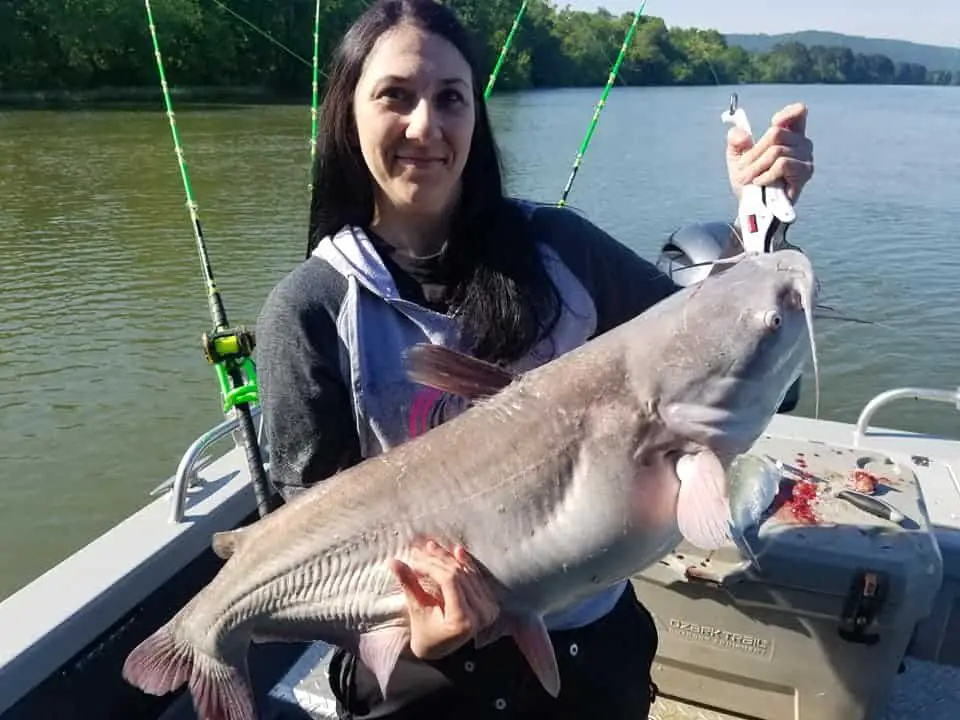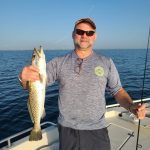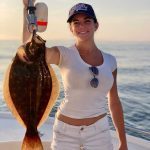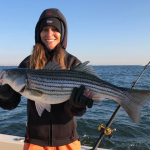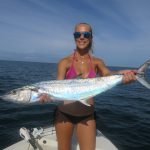Fishing for river catfish, tips and techniques
Many angler associate rivers with catching catfish. This article on fishing for river catfish will cover the tackle, baits, and techniques needed in order to be successful fishing for catfish in rivers.
River catfish rods and reels
Anglers fishing for river catfish will use two basic outfits. Boating anglers will do well with a 7′ to 8′ medium heavy conventional rig. Long casts are seldom required. Spinning outfits are more versatile and can be used by anglers fishing from both shore and a boat. Obviously, spinning outfits are much easier to cast. The rod and reel should be matched to the size of the catfish being sought. Catfish vary greatly by size. Anglers can use a medium outfit for smaller channel catfish, but it is best to err on the heavy side as catfish are often caught need structure. Also, the chance to catch a very big fish is always present.
Anglers can read more about fishing tackle for catfish in this article by Capt Jim
A 7’-8′ medium heavy casting rod with 50-65lb braided and a 12-16 inch 30lb monofilament leader is an excellent all round combination. Baitcast outfits can be tricky and some anglers prefer to use spinning reels. Spinning outfits are easier to cast long distances than conventional and you don’t have the possibility of backlash and bird nesting your reel, which can take hours to correct. An 8′ medium/heavy action rod, 4000 to 5000 series reel spooled up with 50 lb braid is a good all-round spinning outfit for catching larger river catfish.
Click links to shop Amazon for conventional and spinning rod and reel combos
“Fishing Lido Key is a participant in the Amazon Services LLC Associates Program, an affiliate advertising program designed to provide a means for sites to earn advertising fees by advertising and linking to Amazon” 
Terminal tackle for river catfish
Anglers fishing for river catfish have a wide variety of options to choose from when it comes to hooks and sinkers. A few of these will be explored below.
Best catfish hooks and rigs
A standard catfish rig of a large hook such as an 8/0-10/0 catfish hook on a 12 inch to 18 inch leader. Most anglers use circle hooks these days. This is attached to the main line with a swivel, and front of which she slides on a no roll sinker. 3 ounce to 5 ounce sinkers work well and most situations. No roll, or coin sinkers are flat with a hole in the center. They do well in the current, better than other sinker types. 8-10/0 Offset circle hooks are good for flathead and blue catfish while 5/0-8/0 circle hooks are better for channel cats. On occasion a rattle or peg float will be added depending on what the fish are looking for that day.  Adding a peg float to the leader line will often entice those picky catfish into taking the bait when a normal bottom presentation fails to draw strike. Other tricks include using a Demon Dragon rattle float in place of the peg float. These floats, or line rattles, at a bit of noise and motion that will trigger a reaction bite in the bigger males, especially if used during the spawn, when fish are more difficult to catch.
Adding a peg float to the leader line will often entice those picky catfish into taking the bait when a normal bottom presentation fails to draw strike. Other tricks include using a Demon Dragon rattle float in place of the peg float. These floats, or line rattles, at a bit of noise and motion that will trigger a reaction bite in the bigger males, especially if used during the spawn, when fish are more difficult to catch.
Check out these channel catfish fishing tips
Another specialized rig is a whisker bomb. This has the sinker and hook in one basic unit. It works well when catfish are holding tight to cover. It allows for
precise bait placement without hanging up.  The basic 3-way rig is a standard catfish rig that works well when river fishing. A 3 way swivel is tied on to the main line. A short dropper connects the swivel with a sinker. Often, this is lighter line to that if it snags, only the sinker is lost. On the third eye, a leader and hook is attached. This keeps the bait just above the bottom if current is present.
The basic 3-way rig is a standard catfish rig that works well when river fishing. A 3 way swivel is tied on to the main line. A short dropper connects the swivel with a sinker. Often, this is lighter line to that if it snags, only the sinker is lost. On the third eye, a leader and hook is attached. This keeps the bait just above the bottom if current is present.

Best river catfish baits
Most serious river catfish anglers prefer to use fresh cut bait. This disperses in the current, attracting catfish to the bait. Fresh bait is far superior to frozen bait, which can be used in a pinch. Cut bait works well on larger channel catfish as well as blue catfish. Anglers catch their bait with cast nets, traps, or hook and line.
Shad, herring, and sucker are top baits
. 
Live bait fish are used as well and often catch the largest specimens. Flathead catfish in particular feed on live fish, especially green sunfish. Check local regulations regarding catching and using live bait for catfish. There are certainly a myriad of other choices when it comes to catfish baits. Nightcrawlers are a top bait, especially for channel catfish. Livers are good baits, too. Commercially prepared baits work well on smaller fish and on less pressured waters. They are easy and convenient. Crayfish work extremely well for catfish in rivers. River channel catfish received quite a bit of pressure in some rivers, especially those close to cities. They often times do not respond to the standard “stink baits”and prefer a nice juicy chunk of fresh cut sucker or chub minnow.
River catfish techniques

Angling techniques are similar for both boating and shore bound anglers. Those fishing from boats will often target cover, especially on the outside bends in the river. These areas are naturally deeper and the debris offers protection from the high, fast-moving water. The best approach is to anchor up current from the area that is going to be fished and cast down into the snag or hold being targeted. Water level and the corresponding current flow will dictate where the fish will stage up. When the water is high, fast, and dirty, catfish will seek refuge from the current. Sloughs and eddies will be the best spots. The catfish can sit in a good ambush spot without expending a lot of energy. Also, anglers will find it much easier fishing these spots when the current is fast.
Conversely, low water will concentrate the fish in the deeper areas of the river. This is a great time to target these big catfish as there is simply less area in which to look for them. Deeper holes on the outside bends are prime spots to set up during periods of low water. Low water often coincides with warmer water temperatures. Catfish are generally more active during the night during this time. Areas with cooler water will provide daytime action. The shady side of the river with overhanging brush can be a good spot to try.
River catfish vs lake catfish
While catfish are found in both rivers and lake environments, tactics are a bit different. River catfish will use current to their advantage. They will hold in eddies, holes, and around wood. Lake catfish relate more to rock structure. Successful catfish anglers should understand the differences in order to catch the trophy fish we are all looking for.
River catfish tactics
A few differences between lake and river fishing is that in a river the angler will generally battle strong current, heavy debris, barge traffic, and other large species possibly taking the bait. But, with the unpredictability of the river also comes great reward. Anglers can catch multiple trophy flathead catfish in one night opposed to on the lake you may sit for 12 hours and catch one fish, or none.

River conditions have a huge influence on catfish productivity. When the water is high, fast, and full of debris, fishing can be tough. Catfish will seek out protected water such as eddies and tributaries when the river is raging. Rivers can also be very dangerous under these conditions. If fishing the river in less than ideal weather be sure to have a boat and anchors that can hold in the fast current and always wear a life jacket. Before fishing on big rivers under these conditions, anglers should also become familiar with barges and the dangers of fishing in the barge channel or around barges that aren’t in use.
Conversely, when the water is low, fish typically congregate in the deeper holes and channels. Many rivers have many tributaries and large catfish often use them to feed. Catfish anglers use the river current in their favor and will hard anchor and cast off the back of the boat which lets the current carry the scent of the bait, luring catfish towards the boat.
Under normal river conditions, catfish will hold in several locations. Outside bends in the river are prime spots, especially if cover is present. Other productive spots in rivers are the heads and tails of holes or ledges, creek mouths, barges, and sunken structure.
3 main Catfish species
While the three main catfish species are similar, they do have different habits and diets.
Flathead catfish

Flathead catfish are the only catfish of these three species that doesn’t have a forked tail it is slightly notched. Their bottom jaw protrudes out like an “under bite”. They vary in color but are generally a brownish yellow mottled color. They have a “flat head” and can be referred to as shovel head or yellow cat. Like most catfish, they are a bottom dwelling fish. They are a predatory fish and will sometime stalk their prey before eating it, as a general rule they prefer live bait. They can be finicky eaters and mostly feed in shallow waters at night but during the day they travel to deeper water and hide among structure. Popular baits include shad, suckers, blue gill, goldfish, mooneye, skipjack, and crappie.
Blue catfish

Blue catfish have a forked tail and protruding upper jaw. They are a blue color varying in shades of gray and even white. They are often confused with channels but Blues do not have speckles or spots like the channel and they have a straight anal fin. Blues also grow to over 100lbs. They are found mostly in rivers or large lakes or reservoirs they can be found over rocks, sand or wood piles. Blues are considered opportunistic feeders they primarily eat live or fresh cut shad or other fish.
Channel catfish

Channels also have a deep forked tail and have a protruding upper jaw. They vary in color but are often a grey/brown colors and some have speckles or black spots. Their bellies are usually white or silvery and they have a curved anal fin. Channels are not picky eaters and are actually omnivorous. They are the smallest and easiest of these 3 species to catch. They are also bottom dwellers and typically are found in rock piles, log jams, and seaweed. Channels will eat smaller cut baits like shad, suckers, bluegill, but also eat insects, worms, crawfish, hotdogs, stink baits, even some plants.
Catfish pressure
Many very popular catfish rivers get a lot of pressure. The popularity of catching catfish is exploding. Regulations need to keep pace with the demand. This is especially true with the trophy fish in each lake or river system. Those big fish are crucial to the fishery., it is important to release them and if desired, keep a couple small ones for dinner. They are much better to eat anyway. The Red River on the North Dakota/Minnesota border and into Canada is a prime example of a trophy catfish fishery that is highly managed and remains incredibly productive.
I would really like to emphasize that I catch, picture and release or “CPR” all big fish. I do not discourage harvesting fish to provide meals for yourself or family. 2-6lb catfish are the ideal size for “eater fish”. Anything larger than that will be tough, gamey, and an undesirable flavor. It takes many years for catfish to reach “trophy” size. It is best to release those larger fish to breed.

Red River Catfish Tips
This article shares Red River catfish tips, tackle, and techniques. The Red River is acknowledged as the “channel catfish capital of the world”. While this piece focuses on the Red River, these techniques will produce for anglers targeting catfish anywhere. The Red River flows north between Minnesota and North Dakota. It empties into Lake Winnepeg in Manitoba. The river offers excellent fishing in the United States, but anglers seeking a trophy channel cat will do well heading to the Manitoba portion of the Red River. The statistics tell the tale; the Red River gives up the majority of trophy catfish in the region. Anglers looking to catch catfish on the Red River can access it at many different points. The Red River is a relatively slow moving river, often muddy. It is perfect channel catfish habitat. There is plenty of access and shore bound anglers can experience success. Boats are nice, but not required.

Anne is our northern catfish contributor. She is a professional tournament angler from Billings, Montana. She has fished the Scheels Boundary Battle on the Red River in Grand Forks North Dakota for the past three years. Anne catches more than her share of trophy cats, along with many other species available to Red River anglers. She is sharing her wealth of knowledge here for you!
Red River catfish by region
While the entire Red River, both in the United Sates and Canada, can be quite productive, there is a small stretch that makes the river famous. The area from the route 101 Bridge to the Route 4 Bridge in Manitoba offers anglers the opportunity for epic catfish fishing. Though it is a short stretch and it gets a fair amount of fishing pressure, there is plenty of room for visiting anglers to enjoy this unique experience. Fishing in the United States portion of the Red River is excellent for catfish as well. It also offers opportunities for many other species. Fishing baits and techniques for catfish and this portion of the Red River are pretty much the same as in the Canadian stretch. Anglers can find detailed maps with access points and other fishing information HERE. There is a dam at the town of Lockport. This is the only obstruction on the Red River. The tailwater stretch of river below the dam is a top spot for catfish anglers. Despite the popularity of this spot, anglers have a great chance to score on a ten pound catfish on a daily basis. Fish to 15 pounds are common and 20 pound cats are caught on a daily basis.
Red River catfish conservation
North Dakota, Minnesota, and Canada have all recognized incredible opportunity this fishery offers and they work together to regulate the size and quantity of fish that are taken on a daily basis. Utilizing a slot limit, the fishing game departments have allowed the fishery to thrive, while still offering the angler a chance to catch the fish of a lifetime! These groups also work together to tag and monitor the movements of channel catfish through the Red River basin.

Grand Forks guide Brad Durick works with the DNR as well to track and monitor those channel catfish tags. He catches many catfish each year that were tagged in both the United States and Canada. Their research has shown that Channel cats travel much further than previously believed. Brad is a coordinator for the Sheels Boundary Battle tournament. His website is a good source for Red River anglers.
Red River catfish tips; seasons
While the Red River can be productive for much of the year, and recommends the time from May to early June and late July to early October as the prime times to fish Spring can be difficult as a river floods regularly and the fish generally go to spawn in late June. These factors result in more difficult conditions to catch fish. The river is relatively shallow with an average depth of 18 feet. It is also relatively narrow, with a width of 50 to 100 feet in the section that and fishes.

This is generally the case for much of the Red River in the central portion of the North Dakota and Minnesota border. This is one factor that makes it fairly easy to fish. Many anglers are mistaken in thinking that catching a catfish is just a matter of putting out some stinky bait and having a beer while waiting for a bite. Nothing could be further from the truth. Yes, a few fish will be caught this way. However, successful catfish anglers are constantly refining and adjusting their baits and presentations.
Catching Red River catfish from shore
One great thing about the Red River is that anglers without a boat can be just as successful as those with a boat. Access is easy for those fishing from the banks. There are numerous public fishing access sites along the Red River in every major town from Fargo to the Canadian border. A visit to the North Dakota or Minnesota Fish and game websites will give the angler a great idea of where to start.

In Grand Forks in particular, there is a city managed Greenway through the entire length of the river that offers walking pass, benches along the riverside, and historic markers that indicate significant points of interest. Grand Forks was devastated by Red River floodwaters in 1996. Evidence of the power of the river flood can be seen in many different areas of town and its surroundings.
Additional Red River species
While channel catfish get a majority of the attention, the Red River offers visiting anglers the opportunity to catch several other species as well. The fall walleye run can be legendary as fish to ten pounds are taken regularly. The mighty sturgeon may intercept your offering meant for a catfish. Bullhead, burbot, carp, freshwater drum, goldeye, northern pike, rock bass, sauger, and white bass are also available.
Ohio catfish fishing tips with Joanna
This article will share some great Ohio catfish fishing tips. Catfish are a very popular freshwater species and are growing in popularity all over the country.
Catfish are a warm water freshwater species that are abundant in the state of Ohio and throughout the country. They are being targeted more than ever before. Tournaments for catfish are becoming more common. Channel catfish, Flathead catfish, and blue catfish are the most commonly caught catfish species in the United States. Catfish thrive in both Ohio lakes and rivers.

Joanna Rafeld is our Fishing Ladies Ohio catfish expert. She was born in Canton, Ohio and has lived there her entire life. Joanna knows these waters well. She is a VERY enthusiastic catfish angler! This is her story;
I’m 31 years old born and raised in Ohio. I am divorced and have 4 children. During my divorce, I started nursing school after being a Phlebotomist for 8 years and I have been a Registered Nurse for 5 years. I began fishing with my dad and grandpa before I can remember and most of my fondest childhood memories involved an old pontoon on the lake just about every weekend. Memories include sleeping on the boat and hearing the bell on my dads fishing pole start ringing and the boat simultaneously would start rocking under me as he ran for his rod.
Targeting trophy catfish
During my divorce I began fishing more often and started learning my own techniques of how to be a successful fisherman. Once, I read a quote that said “Sometimes, you find yourself in the middle of nowhere, and sometimes, in the middle of nowhere you find yourself.” Being by the water and fishing, whether catching fish or not, is the most relaxing, and often rewarding, places I have found. I started catching Ohio catfish about 6 years ago, mainly channel cats in ponds or lakes in the Muskingum Watershed.
I recently began targeting trophy flathead catfish and tournament catfishing about 3 years ago. Currently, I am a sponsored angler by Reddi Bait located in Bridgewater, PA, Anvil Rods, and Beaver Marine in Magnolia, Ohio. River fishing is my favorite, though I do fish in lakes as well. I am strictly catch and release and am an advocate for large catfish conservation.”
After our spring fishing season kicks off in Ohio I keep my rods, cast net and a bucket in my minivan. I do this in case I see a new bait hole or have a few minutes to throw a line out. Most of my friends call me crazy and don’t understand why I love catching Ohio catfish so much. Being a female angler can be controversial at times. I’ve found many fishermen don’t take women that enjoy fishing seriously.”
More women seeking catfish
Meanwhile, the female fisherman that spends hours upon hours catching bait, rigging rods, and catching record sized fish is overlooked because she is in a hoodie and thermal pants. I think more women would love the sport of fishing if we removed the stigma of what a “fisherman” is to most. Hopefully, with the recent increase in publicity of lady angling, the number of female fisherman will go up as well.

I take my kids to catch bait with me most days and we camp and fish often during the summer. I hope I am creating the memories that I was fortunate to have as a child. Catching Ohio catfish is not only my hobby but it is my passion and I enjoy sharing it with my family and friends. There is nothing I love more than watching someone reel in a new personal best fish. I personally prefer the quality over quantity of catfishing.
I generally use large live bait, and would much rather catch one 50lb flathead instead of twenty small channel cats in one night. Sometimes, that doesn’t work in my favor and I may not catch anything by using large baits and waiting on that new state record flathead to bury my rod, and I’m okay with that.
Fresh bait is the best for catching catfish
I use a cast net to catch my fresh live bait which is primarily suckers, shad, and creek chubs. Different times of year the fish prefer live bait over frozen or cut bait and vice versa. My personal favorite bait is a live 8-10 inch sucker. Throwing a cast net takes a lot of practice and a lot of nets. Reddi Bait in Bridgewater, PA can handle the bait for you if you’re short on time or unable to throw a cast net. They carry live bait as well as frozen shad and herring.
Ohio catfish fishing tips; Thermocline fishing
If you have a depth finder you can visibly see the thermocline and can adjust your floats to ensure you stay above the thermocline. If you don’t have a depth finder or are fishing from the bank it might take a little trial and error before figuring out where that thermocline is. I suggest staggering your baits so you have some variability and whether they’re above, below, or on the edge of the thermocline you will find them. The thermocline can be tricky and frustrating but very rewarding during the dog days of summer. Our state record Flathead was caught out of a Muskingum Watershed lake and we typically see much larger fish in lakes opposed to rivers here. Early spring flatheads are found mostly in shallow back waters. Pre-Spawn and Post spawn they can still be caught in slack shallow water but are primarily targeted near heavy structure, deep holes, ledges, or wood. Catfish anglers seeking numbers of fish in lakes as opposed to a trophy should change tactics just a bit. Hook sizes can be dropped down to a 3/0-5/0. The top baits when seeking numbers of channel catfish in the lake are shrimp, hotdogs, and night crawlers. Some people can even use crappie jigs to jig catfish! I’ve never personally done that but have seen it work for some.
In conclusion, this article on fishing for river catfish will help you catch some trophy catfish!
